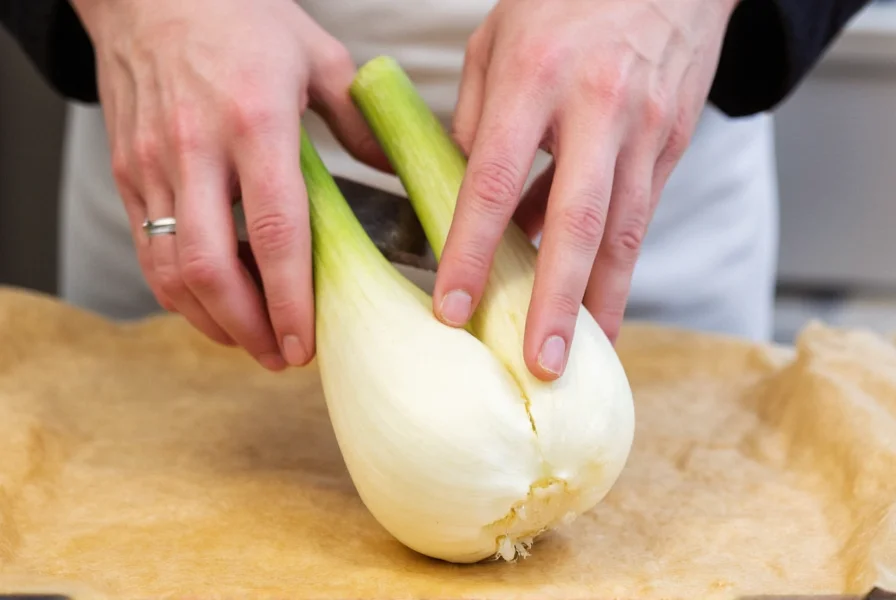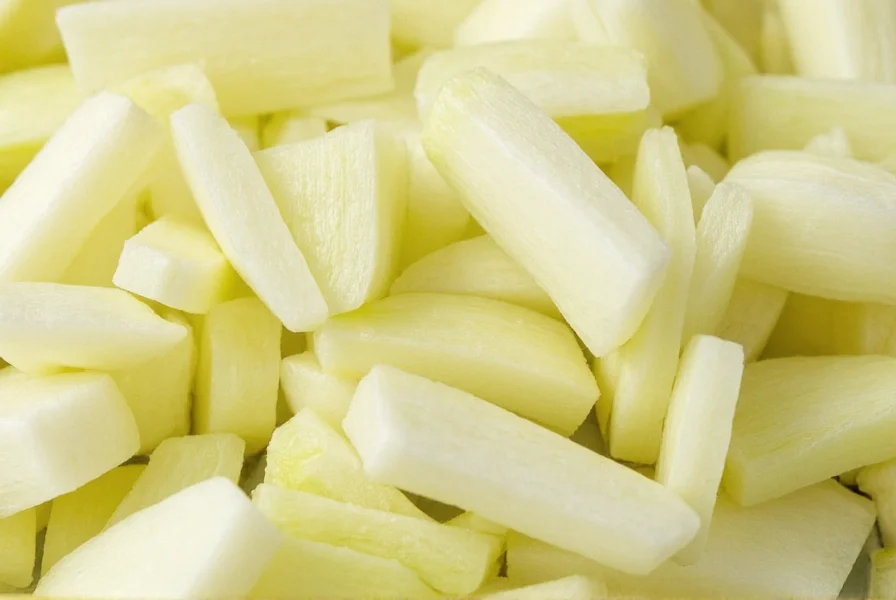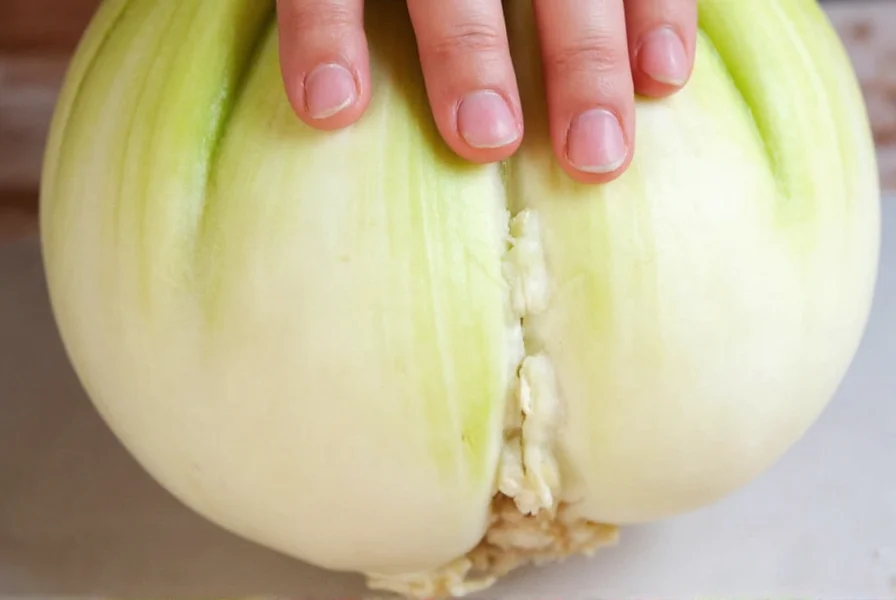Mastering the art of cutting fennel bulb transforms this elegant vegetable from intimidating to approachable. Many home cooks struggle with fennel's unique structure, leading to wasted produce or uneven cooking. Proper technique preserves fennel's delicate anise flavor while ensuring consistent texture in dishes from salads to roasts.
Essential Tools for Cutting Fennel
You don't need specialized equipment, but having the right basics makes the process smoother:
- Sharp chef's knife (8-10 inches)
- Stable cutting board
- Vegetable peeler (optional for tough outer layers)
- Bowl for collecting fronds

Step-by-Step Fennel Preparation
1. Initial Cleaning and Trimming
Begin by rinsing the entire fennel bulb under cold water to remove any dirt between layers. Shake off excess moisture. Place the bulb upright on your cutting board and use your chef's knife to trim the stalks approximately 1 inch above the bulb. Don't discard these stalks—they're perfect for stocks and soups. Next, cut off the root end flush with the bulb base.
2. Removing Outer Layers
Examine the bulb for any discolored or tough outer layers. While young fennel often has tender layers requiring no peeling, mature bulbs typically need one or two layers removed. Simply peel these away by hand—they should come off easily. This step reveals the crisp, pale interior perfect for slicing.
3. Core Removal Technique
Place the bulb flat-side down. Make a vertical cut through the center to divide it in half, then cut each half again to create quarters. You'll notice a tough triangular core in each section. To remove it, angle your knife diagonally and slice out this hard center portion from each quarter. This crucial step prevents unpleasant chewy bits in your finished dish.
| Cutting Style | Best For | Technique Tips |
|---|---|---|
| Thin Slices | Salads, slaws | Cut perpendicular to core lines for uniform pieces |
| Medium Dice | Sauces, braises | Stack slices before dicing for efficiency |
| Wedges | Roasting, grilling | Leave core intact for structural integrity |
Maximizing Fennel's Culinary Potential
Understanding how to cut fennel bulb properly affects both flavor and texture in your dishes. The direction you slice relative to the core's natural fibers determines tenderness—cutting against the grain yields more delicate results. When preparing raw fennel for salads, soak sliced pieces in ice water for 15 minutes to enhance crispness and mellow the licorice notes.
Don't waste the feathery fronds! These delicate greens make an excellent garnish with flavor similar to dill. Chop them finely and sprinkle over finished dishes. The tougher lower stalks work wonderfully in vegetable stocks or as a flavor base for soups—simply chop coarsely and freeze for later use.

Avoiding Common Fennel Cutting Mistakes
Many cooks make these critical errors when learning how to prepare fennel bulb:
- Skipping core removal - This tough center won't soften during cooking
- Cutting with the grain - Creates stringy, unpleasant texture
- Using a dull knife - Crushes rather than slices the delicate layers
- Discarding edible parts - Stalks and fronds add flavor to many dishes
For optimal freshness, store cut fennel in an airtight container with a slightly damp paper towel. Properly stored, it maintains quality for 3-4 days in the refrigerator. When working with multiple bulbs, prepare them sequentially rather than all at once to prevent premature browning.
Advanced Fennel Preparation Techniques
Professional chefs employ these specialized methods when cutting fennel bulb for specific applications:
- For braising: Cut into thick wedges (1.5 inches) with core intact to maintain shape during slow cooking
- For salads: Use a mandoline for paper-thin slices, then toss with citrus to prevent oxidation
- For soups: Rough chop stalks and bulb together for even cooking and flavor distribution
When following recipes that call for "1 fennel bulb," understand that sizes vary considerably. A medium bulb typically yields about 2 cups diced. Adjust quantities based on your bulb's actual size rather than counting whole bulbs for consistent results.
Frequently Asked Questions
Can you eat the entire fennel bulb after cutting?
Yes, all parts of the fennel bulb are edible after proper preparation. The white bulb forms the main edible portion, while the green stalks work well in stocks, and the feathery fronds make excellent garnishes. Only the tough core center and any damaged outer layers should be discarded.
Why does my cut fennel turn brown quickly?
Fennel oxidizes when exposed to air, similar to potatoes. To prevent browning, store cut pieces in acidulated water (water with lemon juice or vinegar) or toss with citrus dressing immediately. For short-term storage, place a damp paper towel in the container with your cut fennel.
How thin should I slice fennel for salads?
For raw fennel salads, aim for paper-thin slices (about 1/16 inch thick) using a sharp knife or mandoline. Thinner slices provide better texture and allow the anise flavor to distribute evenly. Soak the slices in ice water for 15 minutes before dressing to enhance crispness and mellow the flavor.
What's the best way to cut fennel for roasting?
For roasting, cut fennel into 1-inch thick wedges while keeping the core intact to maintain structural integrity during cooking. This size ensures even caramelization without falling apart. Toss with olive oil, salt, and pepper, then roast cut-side down at 400°F for 25-30 minutes until golden and tender.











 浙公网安备
33010002000092号
浙公网安备
33010002000092号 浙B2-20120091-4
浙B2-20120091-4